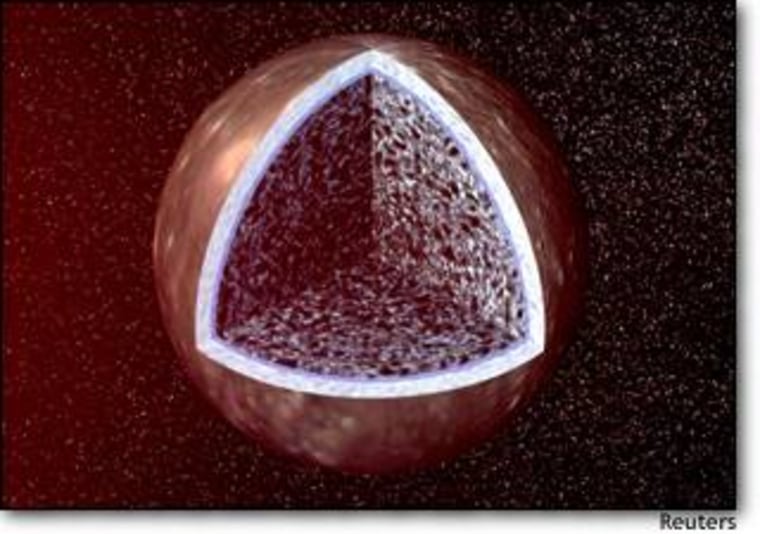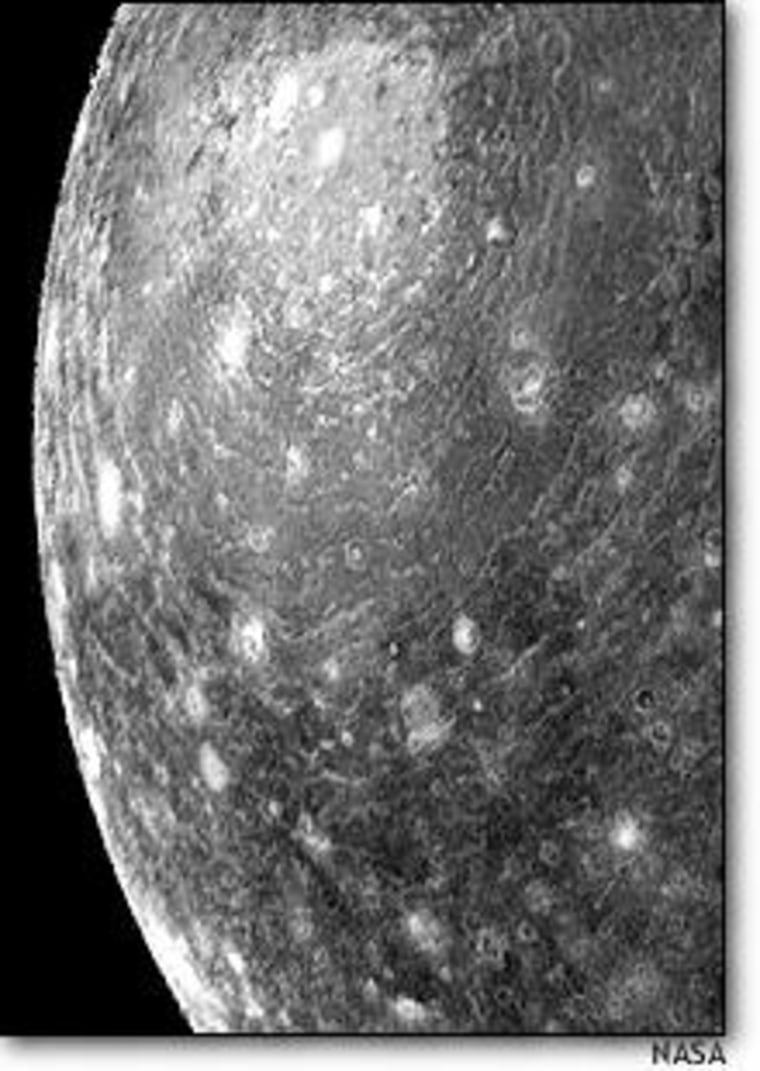Magnetic readings taken by the Galileo spacecraft indicate that a watery ocean lies beneath the icy surface of Europa, one of Jupiter’s moons. That doesn’t come as much of a shock anymore. But here’s the big surprise: The readings also show that there may be a subsurface ocean on a sister moon, Callisto.
“The results are totally unexpected,” said Krishan Khurana, a geophysicist at the University of California at Los Angeles.
Khurana and colleagues at UCLA, the California Institute of Technology and NASA’s Jet Propulsion Laboratory reported the new findings in Thursday’s issue of the journal Nature. They could fuel a fresh round of speculation about whether watery moons could harbor life beyond Earth.
The scientists based their conclusion on magnetometer readings from Galileo, which has been orbiting Jupiter since 1995. Neither Europa nor Callisto appear to have a strong internal magnetic field, but such fields are created as they pass through Jupiter’s powerful magnetosphere.
UCLA space physicist Margaret Kivelson, the principal investigator for Galileo’s magnetometer, compared it to what happens when an electrical current is generated by a dynamo: When a conducting material such as copper wire passes through a magnetic field, a smaller magnetic field is induced around the wire.
Magnetic mystery
In the case of Europa and Callisto, which are both covered with a layer of water ice, Galileo detected an induced magnetic field — and a pretty strong one at that, indicating that electrical current was flowing somewhere close to the surface. But what is the conducting material on Jupiter’s moons?
“It turns out that ice is not a good electrical conductor,” Kivelson said. “So we don’t think the current can be carried in ice as ice. But as ice begins to melt, then electrolytes begin to dissolve, and then they can carry that current.”
The researchers said the most plausible explanation for the magnetic effect was that Europa as well as Callisto have liquid oceans containing electrolytic salts.
“As in sea water on Earth, the electrolytes may come from leaching from ‘rocky’ material,” University of Cologne researcher Fritz Neubauer wrote in a commentary also published by Nature.
However, Khurana cautioned, “we cannot say for sure that we have seen the unmistakable signature of liquid water. ... We’re suggesting something very non-obvious.”
There could be alternate explanations — for example, if Callisto’s interior contained a globe-girdling layer of pure iron 100 feet thick, it might produce the same magnetic signature, Khurana said.
Europa vs. Callisto
For years, researchers have cataloged evidence that Europa had a subsurface ocean, drawing on images and gravity data from Galileo. There is even evidence that water or slush periodically welled up from Europa’s interior to the surface.
No such evidence has been seen on Callisto, however. Khurana said that may be because Callisto’s icy crust goes much deeper than Europa’s. The best guess from planetary scientists is that the ice on Europa is just a few miles thick, with an ocean going perhaps 100 miles down below that.
In contrast, Khurana’s team estimates that the ice on Callisto could be a solid 60 miles thick, covering an ocean with a depth of six miles. “The pressures would be enormous,” Khurana said.
“We do know that Callisto’s outer surface is very, very old, so that water inside is not in contact with the outer environment,” he said.

Some scientists speculate that Europa’s oceans, heated by interior tidal forces, could harbor exotic life forms. But Khurana said it would be premature to indulge in speculation about life on Callisto, which generates less internal heat.
Determining definitively whether Callisto has a subsurface ocean would require much more detailed magnetic and gravitational readings, Khurana said. Those readings could be made by an orbiter — perhaps like the orbiter due to be launched toward Europa in the next decade. Khurana said a network of robotic observatories on the moons’ ice, equipped with magnetometers and seismometers, would do an even better job.
Jupiter has two other large moons and a dozen smaller ones. One of the large moons, Io, is highly volcanic and not considered a good candidate for harboring liquid water. Another moon, Ganymede, has such a strong magnetic dynamo effect that it’s hard to detect the kind of induced field found on Europa and Callisto.
Might there be water hidden beneath Ganymede’s surface? “We haven’t ruled it out,” Kivelson said.
